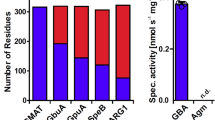Abstract
SODIUM azide produces extrapyramidal symptoms with necrosis of the cerebral cortex, cerebellum, and basal ganglia. Toxicity with this metabolic inhibitor may also include hypotension, blindness and hepatic necrosis1–5. Many hormones and drugs mediate their effects by altering the intracellular levels of cyclic AMP and/or cyclic GMP6–10. We found that NaN3 increases cyclic GMP levels in incubations of slices from cerebral cortex, cerebellum or liver, and also stimulates guanylate cyclase activity. In contrast to other agents that can increase cyclic GMP accumulation in tissues the effect of NaN3 is observed in the absence of added calcium.
This is a preview of subscription content, access via your institution
Access options
Subscribe to this journal
Receive 51 print issues and online access
$199.00 per year
only $3.90 per issue
Buy this article
- Purchase on Springer Link
- Instant access to full article PDF
Prices may be subject to local taxes which are calculated during checkout
Similar content being viewed by others
References
Hurst, E. W., Brain, 67, 103–124 (1944).
Mettler, F. A., and Sax, D. S., Brain, 95, 505–516 (1972).
Miyoshi, K., Acta Neuropath., 9, 199–216 (1967).
Graham, J. D. P., Br. J. Pharmac., 4, 1–6 (1949).
Williams, A. O., Br. J. exp. Path., 48, 180–187 (1967).
Robison, G. A., Butcher, E. W., and Sutherland, E. W., Cyclic AMP (Academic, New York, 1971).
Goldberg, N. D., O'Dea, R. F., and Haddox, M. K., Adv. Cyclic Nucleotide Res., 3, 155–223 (1973).
Schultz, G., Hardman, J. G., Schultz, K., Baird, C. E., and Sutherland, E. W., Proc. natn. Acad. Sci. U.S.A., 70, 3889–3893 (1973).
Murad, F., and Kimura, H., Biochim. biophys. Acta, 343, 275–286 (1974).
Kimura, H., Thomas, E., and Murad, F., Biochim. biophys. Acta, 343, 519–528 (1974).
Gilman, A. G., and Murad, F., in Meth. Enzym., 38, part C, 48–61 (edit. by Hardman, J., and O'Malley, B.) (Academic, New York, 1974).
Steiner, A. L., Parker, C. W., and Kipnis, D. M., J. biol. Chem., 247, 1106–1113 (1972).
Kimura, H., and Murad, F., J. biol. Chem., 249, 329–331; 6910–6916 (1974); 250, 4810–4817 (1975); Metabolism, 24, 439–445 (1975).
Lowry, O. H., Rosebrough, N. J., Farr, A. L., and Randall, R. J., J. biol. Chem., 193, 265–275 (1951).
Baxter, C. F., and Roberts, E., J. biol. Chem., 236, 3287–3294 (1961).
Dixon, M., and Webb, E. C., Enzymes, 315–359 (Academic, New York, 1964).
Author information
Authors and Affiliations
Rights and permissions
About this article
Cite this article
KIMURA, H., MITTAL, C. & MURAD, F. Increases in cyclic GMP levels in brain and liver with sodium azide an activator of guanylate cyclase. Nature 257, 700–702 (1975). https://doi.org/10.1038/257700a0
Received:
Accepted:
Issue Date:
DOI: https://doi.org/10.1038/257700a0
This article is cited by
-
Discovery of Some of the Biological Effects of Nitric Oxide and its Role in Cell Signaling
Bioscience Reports (2004)
-
Oxygen-radical/nitric oxide mediate calcium-dependent hormone action on cyclic GMP system: A novel concept in signal transduction mechanisms
Molecular and Cellular Biochemistry (1995)
-
Histochemistry of nucleotidyl cyclases and cyclic nucleotide phosphodiesterases
The Histochemical Journal (1988)
-
Lithium ions inhibit function of lowbut not high-affinity muscarinic receptors of murine neuroblastoma cells (clone N1E-115)
Psychopharmacology (1985)
Comments
By submitting a comment you agree to abide by our Terms and Community Guidelines. If you find something abusive or that does not comply with our terms or guidelines please flag it as inappropriate.



